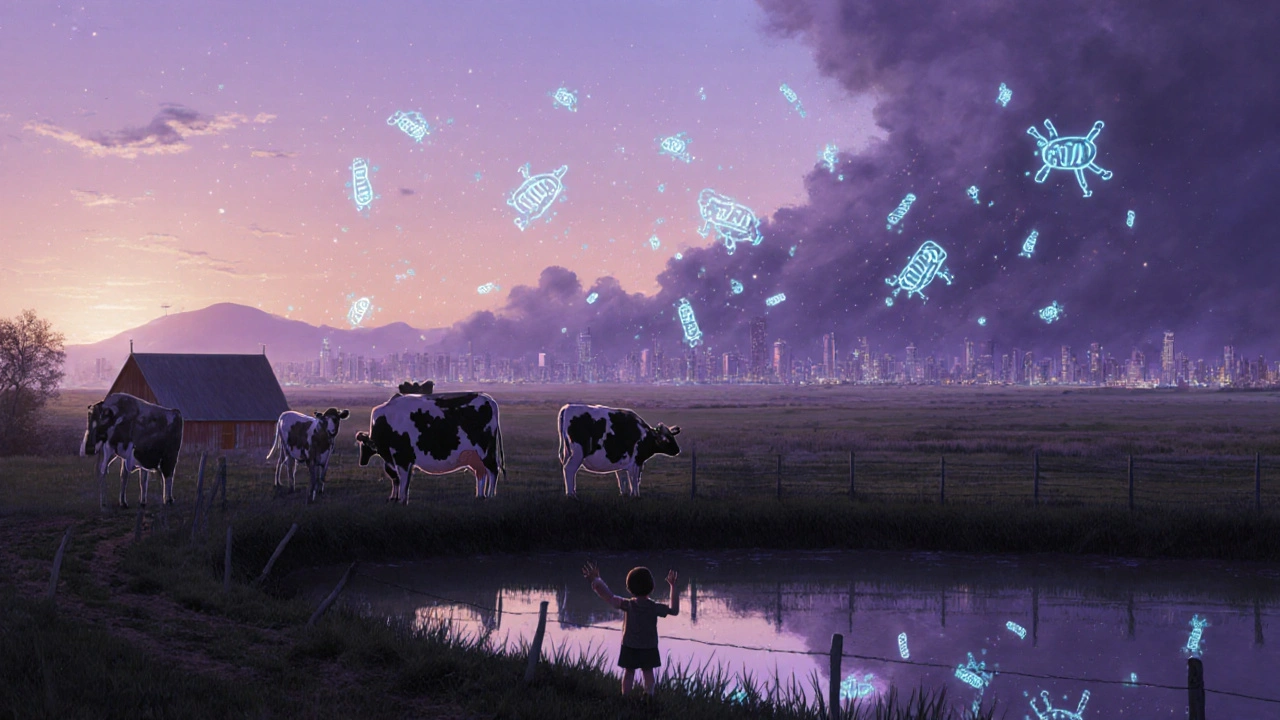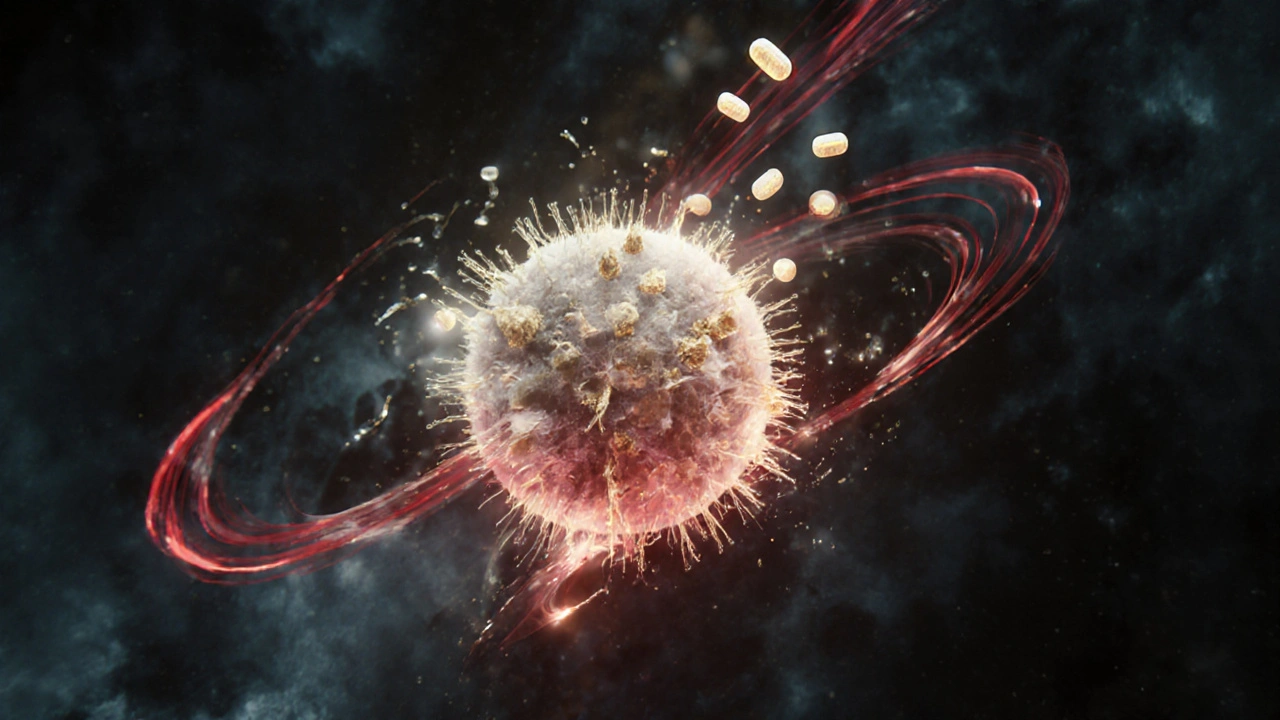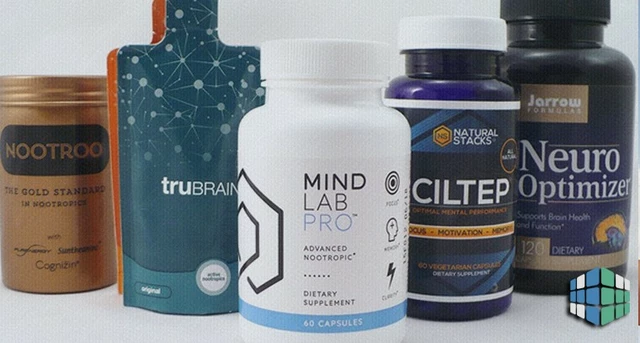Every time you take an antibiotic when you don’t need it, you’re not just helping yourself-you’re helping bacteria become stronger. That’s not a metaphor. It’s biology in action. Antibiotic resistance isn’t something that’s coming. It’s already here, and it’s killing more than a million people every year worldwide. The problem isn’t just that we’re running out of drugs. It’s that the bacteria are evolving faster than we can keep up-and they’re doing it because of how we use antibiotics.
How Bacteria Become Unkillable
Bacteria don’t wake up one day and decide to resist antibiotics. They evolve. And they do it through mutations-tiny, random changes in their DNA that give them a survival edge. When an antibiotic kills most of the bacteria in a population, the few that happen to have the right mutation survive. They multiply. And suddenly, the whole group is resistant. These mutations aren’t magic. They follow patterns. Studies tracking bacteria exposed to low doses of antibiotics over generations show that resistance doesn’t appear all at once. It builds in stages. First, bacteria tweak how they control their genes. Then, they change their physical structure. Finally, they lock in those changes with permanent DNA mutations. For example, when bacteria face amoxicillin, they often mutate the ampC gene. That gene normally helps build cell walls. When it changes, the antibiotic can’t bind properly. With cefepime, it’s the pbp genes that flip. These genes code for proteins that antibiotics target. Mutate them, and the drug becomes useless. Even more concerning: resistance isn’t always caused by one mutation. Sometimes, it’s a chain reaction. Take tetracycline. Bacteria don’t naturally have a strong defense against it. But when exposed over time, they start making random changes in their DNA that accidentally turn on existing defense systems. One study found that a transposon-a piece of DNA that can jump around-inserted itself into the promoter region of the acrAB gene cluster. That single change turned on a pump that pushes antibiotics out of the cell. The bacteria didn’t evolve a new tool. They just turned an old one on full blast. And here’s the kicker: most of the early mutations don’t stick around. In one study, only 8% to 20% of the mutations seen halfway through resistance development were still present by the end. That means bacteria are constantly testing new changes, discarding the ones that don’t help, and keeping the ones that do. It’s evolution on fast-forward.The Role of Antibiotic Use-And Misuse
Mutations happen naturally. But without pressure, they rarely take over. That’s where human behavior comes in. Antibiotics don’t cause mutations. But they create the perfect environment for resistant strains to win. In the U.S., about 30% of outpatient antibiotic prescriptions-roughly 47 million a year-are unnecessary. That’s colds, flu, and viral infections treated with drugs that do nothing. In hospitals, antibiotics are often given “just in case,” even when there’s no clear infection. In farming, antibiotics are routinely added to animal feed to make livestock grow faster. That’s not treatment. That’s exposure. Each time an antibiotic is used unnecessarily, it wipes out the weak bacteria and leaves behind the tough ones. Those survivors spread. They pass their resistance genes to other bacteria-even different species-through horizontal gene transfer. That’s how a harmless gut bacterium can end up carrying a gene that makes it resistant to last-resort antibiotics. It’s not just antibiotics, either. Recent research shows that some common painkillers, antihistamines, and even antidepressants can trigger bacteria to take up resistance genes from their environment. You’re not just exposing bacteria to drugs. You’re exposing them to chemical signals that tell them: “Get ready to fight.”
Why This Isn’t Just a Hospital Problem
Antibiotic resistance doesn’t stay in hospitals. It moves through water, soil, food, and air. Bacteria from livestock farms wash into rivers. Wastewater treatment plants can’t filter out resistant strains. People who never took an antibiotic can still get infected by a superbug from contaminated produce or drinking water. The One Health approach-linking human, animal, and environmental health-isn’t just a buzzword. It’s the only way to understand this crisis. A resistant strain that starts in a pig farm in Iowa can end up in a patient’s bloodstream in New York. A gene that evolves in a hospital in India can show up in a hospital in Dallas within months. The numbers are brutal. In the European Union alone, antibiotic resistance causes 33,000 deaths each year and costs €1.5 billion in healthcare and lost productivity. Globally, it’s 1.27 million deaths annually. By 2050, if nothing changes, the World Bank estimates AMR could push 24 million people into extreme poverty.What Can Be Done? It’s Not Just About New Drugs
We’ve been told the solution is new antibiotics. But here’s the truth: the pipeline is dry. Of the 67 antibiotics currently in clinical development, only 17 target the most dangerous pathogens. Only 3 are truly new-designed to bypass existing resistance. The rest are tweaks on old drugs. Bacteria will outpace them, too. The real solution is smarter use. That’s called antibiotic stewardship. Hospitals with strong stewardship programs have cut inappropriate antibiotic use by 20-30% without making patients sicker. How? They stop giving antibiotics until tests confirm a bacterial infection. They use narrow-spectrum drugs instead of broad ones. They shorten treatment courses when possible. They track resistance patterns in real time. But it’s not just hospitals. It’s doctors. It’s patients. It’s farmers. If you have a sore throat and a fever, don’t demand antibiotics. Ask: “Could this be viral?” If you’re prescribed an antibiotic, ask: “What’s the target bacteria? Why this drug? How long do I really need to take it?” Don’t stop because you feel better. Finish the full course-or don’t start it at all if it’s not needed. If you’re a parent, don’t save leftover antibiotics for the next cold. That’s how resistant strains get a second chance. If you’re a farmer or work with animals, support policies that ban routine antibiotic use in livestock. The EU and Canada have already done this. The U.S. is moving slowly.
The Future: Fighting Back With Science
Science isn’t standing still. Researchers are using CRISPR to target and destroy resistance genes inside bacteria. Others are mapping bacterial metabolism to find weak spots-like the metabolic pathways that help resistance become permanent. One study found that resistance genes linked to carbohydrate metabolism are the ones that stick around. Target those, and you might stop resistance before it locks in. New diagnostic tools can now identify resistance genes in hours, not days. That means doctors can choose the right drug faster, avoiding broad-spectrum overuse. And there’s hope in policy. Over 150 countries have national action plans for fighting antibiotic resistance. But execution varies wildly. High-income countries are at 75% implementation. Low-income countries are at 35%. Global coordination is still weak. We’re not powerless. But we’re running out of time.What You Can Do Today
- Never take antibiotics unless a doctor confirms a bacterial infection.
- Never share or use leftover antibiotics.
- Finish your full course-if you’re prescribed one.
- Ask your doctor: “Is this really necessary?”
- Support meat and dairy products from animals raised without routine antibiotics.
- Wash your hands regularly. Preventing infection is the best way to avoid needing antibiotics.
Can antibiotic resistance be reversed?
It’s possible, but not easy. When antibiotic use drops, resistant bacteria can lose their advantage and become less common over time. For example, after Denmark banned growth-promoting antibiotics in pigs, resistance in farm bacteria dropped significantly within a few years. But once a resistance gene becomes widespread, especially if it’s carried on mobile DNA, it rarely disappears completely. The goal isn’t to reverse it-it’s to stop it from getting worse.
Are natural remedies like honey or garlic effective against resistant bacteria?
Some natural substances, like medical-grade honey, have shown antibacterial properties in lab studies and are used in wound care. Garlic has compounds that can slow bacterial growth in test tubes. But these aren’t replacements for antibiotics in serious infections. They don’t work the same way, aren’t standardized, and can’t be relied on for systemic infections like pneumonia or sepsis. Using them instead of proven treatment can be dangerous.
Why do doctors sometimes prescribe antibiotics for viral infections?
It’s not ideal, but it happens. Sometimes, it’s hard to tell if an infection is viral or bacterial right away. In children, a fever and cough might be a virus-but parents worry about pneumonia. Doctors may prescribe antibiotics to prevent complications, especially if they think the patient might not return. But this is exactly the behavior that fuels resistance. Better testing and patient education are reducing this, but it’s still common.
Do probiotics help prevent antibiotic resistance?
No. Probiotics can help restore gut bacteria after antibiotics and reduce side effects like diarrhea, but they don’t stop resistance from developing. In fact, some probiotic strains carry resistance genes themselves. The idea that taking probiotics makes you “immune” to resistant bacteria is a myth. They don’t block gene transfer or kill resistant strains.
Is antibiotic resistance only a problem in developing countries?
No. While access to antibiotics is higher in wealthy countries, so is misuse. The U.S. and Europe have some of the highest rates of inappropriate prescribing. Resistance genes don’t respect borders. A resistant strain born in India can be in a hospital in Texas within days through travel or food imports. This is a global crisis, not a regional one.
What’s the difference between antibiotic resistance and antimicrobial resistance?
Antibiotic resistance refers only to bacteria becoming resistant to antibiotics. Antimicrobial resistance (AMR) is broader-it includes resistance to antivirals, antifungals, and antiparasitics. But since antibiotics are the most commonly misused and the most critical for modern medicine, the terms are often used interchangeably in public discussions. The real threat is AMR, but antibiotic resistance is the biggest part of it.





Justin Daniel
November 23, 2025 AT 22:59So we’re basically playing Russian roulette with antibiotics, and the bacteria? They’re the ones with the loaded gun. 😅
Melvina Zelee
November 25, 2025 AT 21:19my brain just exploded reading this. like… we’re not even trying to be smart about this? we treat antibiotics like candy at the corner store. and then we’re shocked when the bacteria start winning? 🤦♀️
ann smith
November 27, 2025 AT 17:49This is one of the most important topics of our time. Thank you for laying it out so clearly. Small changes in how we use antibiotics can save millions of lives. Let’s not wait for a crisis to act.
💙
Julie Pulvino
November 29, 2025 AT 01:21I had no idea that painkillers and antidepressants could be contributing to resistance. That’s wild. I guess everything we swallow has consequences we never think about.
Still, it’s kinda comforting to know science is working on CRISPR fixes. Maybe we’re not doomed after all 😌
Patrick Marsh
November 30, 2025 AT 18:05Stop. Don’t take antibiotics unless confirmed. Finish the course. Don’t save leftovers. Wash hands. Support responsible farming.
That’s it. That’s the whole list.
Do it.
Now.
Danny Nicholls
December 2, 2025 AT 06:19bro. i literally saved my last amoxicillin for my next cold. 🤦♂️
now i’m gonna throw it out. and tell my mom to stop asking me for antibiotics for her sinus thing. it’s just allergies. again. 😅
also-i just bought chicken from a farm that doesn’t use antibiotics. feels good. kinda like voting with your wallet. 🐔✨
Nikhil Chaurasia
December 4, 2025 AT 01:07In my village in India, we used to get antibiotics from the local shop without prescription. People thought it was medicine for everything. Now, when someone gets a real infection, the drugs don’t work. We are paying the price. This isn’t just a Western problem-it’s a human problem.
Shawn Daughhetee
December 5, 2025 AT 03:50the part about transposons jumping into the acrAB gene and turning on the pump… that’s insane
it’s like the bacteria are hackers and the DNA is their code
we’re fighting a species that learns faster than we can write new drugs
Ravi Kumar Gupta
December 5, 2025 AT 16:16When I was a child in rural India, my grandmother used turmeric paste on wounds. Today, I work in a hospital where even a simple cut can turn deadly because of resistant bacteria. We lost the balance. We thought science could fix everything. But nature doesn’t care about our arrogance.
james lucas
December 7, 2025 AT 08:39you know what’s wild? the fact that resistance doesn’t even need to be a brand new mutation-sometimes it’s just flipping a switch that was already there. like, bacteria had this pump sitting around for millions of years just chilling, and then we gave them the remote control and said ‘go nuts.’
and now we’re mad they turned on the TV at 3am? come on.
also, i just asked my doctor for a test before my last antibiotic. he looked at me like i was from the future. i’m proud of myself.
manish chaturvedi
December 9, 2025 AT 06:02The One Health framework is not merely a policy recommendation-it is an ethical imperative. Human health cannot be separated from animal health or environmental integrity. The current fragmentation of global health governance is a failure of imagination. We must act as a single system, not as isolated nations.
Holly Schumacher
December 9, 2025 AT 13:52Actually, you’re wrong about honey. Medical-grade honey is FDA-approved for wound care and has been shown in peer-reviewed studies to inhibit biofilm formation in MRSA. It’s not a ‘natural remedy’-it’s a clinically validated antimicrobial agent. And garlic? Allicin has documented bactericidal effects at concentrations achievable in vitro. You’re dismissing evidence because it’s ‘natural.’ That’s not science. That’s bias.
Michael Fitzpatrick
December 11, 2025 AT 09:20I’ve been thinking about this a lot since my kid got pneumonia last year. We were lucky-she responded to the right antibiotic. But I couldn’t help wondering: what if we’d waited a few more days? What if the doctor had just prescribed something ‘just in case’? We almost lost her. And now I realize… the real danger isn’t the bacteria. It’s the fear. The fear of being wrong. The fear of being blamed. The fear of ‘doing nothing.’
But doing nothing… is sometimes the most powerful thing we can do.
Thank you for writing this. It gave me the courage to ask the right questions next time.